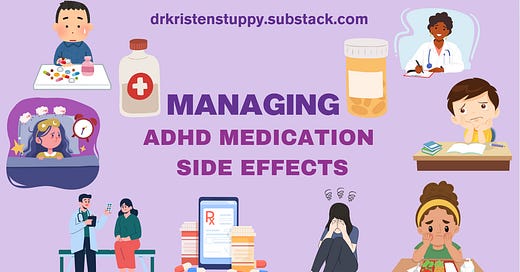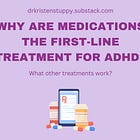Medications can be an essential tool in helping people with ADHD manage symptoms and improve their daily functioning, particularly in areas like attention, impulsivity, and hyperactivity.
If you missed my recent post on why medications are considered first-line treatment for most people with ADHD, you can find it here:
While ADHD medications are generally safe and effective, they can also produce side effects. These side effects should not scare anyone away from trying medications — while it can take time to find the best medicine at the best dose, most people find it to be worth it. When symptoms of ADHD are well managed, people can thrive!
Today I want to discuss how to optimize treatment by starting at low doses, titrating medication to achieve the best therapeutic effect, and using strategies to manage some of the most common side effects.
Benefits of ADHD Medications
ADHD medications, particularly stimulants, have been extensively studied and proven effective in reducing ADHD symptoms in both children and adults. For many people with ADHD, the benefits include:
Improved Focus and Attention: Stimulant medications help the ADHD brain stay on task, particularly in academic, work, and social settings. (Yes, people with ADHD can focus for hours on favorite tasks, even without medication. That’s hyperfocus and can be problematic in many ways.)
Reduced Impulsivity and Hyperactivity: Medications can help children (and adults) with ADHD think before they act, allowing them to better regulate their behavior. This can help them succeed with socially appropriate and expected behaviors.
Enhanced Self-Control and Academic Performance: Many students have improved academic performance and an increased ability to follow instructions and complete tasks while medicated.
Starting Low and Titrating to Find the Right Dose
One of the most effective ways to balance the benefits of ADHD medication with the risk of side effects is to start with a low dose. Pediatricians and psychiatrists typically recommend a “start low, go slow” approach, which involves beginning with the smallest dose that may be effective and gradually increasing it, known as titration, until an optimal dose is reached.
Titration allows prescribers to monitor the response to the medication carefully, looking for improvement in symptoms while limiting side effects. This process may take several weeks or even months, requiring ongoing communication between the parent, child, and physician.
Common Side Effects and How to Manage Them
Though ADHD medications can make a positive difference, side effects are a common concern for parents and teens.
Here are some of the most common side effects and strategies to manage them.
1. Appetite Suppression and Weight Loss
Many people have a reduced appetite while taking stimulant medications. This can sometimes lead to weight loss, especially when medication is taken during the day when they are most active and need balanced meals.
Eat Outside Medication Times: Eat before taking stimulant medication in the morning or after the effects have worn off in the evening. Nutritious snacks in the afternoon followed by dinner later in the evening can help maintain adequate calorie intake.
High-Calorie Snacks: Think of snacks as mini meals! Choose nutrient-dense, calorie-rich snacks, like smoothies, avocados, peanut butter, cheese, or nuts, to help balance overall intake if meal sizes are reduced.
Monitor Growth and Nutrition: Regularly tracking your child’s weight and growth with your prescriber and adjusting medications as indicated helps ensure that any appetite suppression doesn’t lead to nutritional deficiencies and growth problems.
Appetite Stimulants: Sometimes an appetite stimulant is given to counteract the appetite suppressant effects of medications. This is something to discuss with your prescriber if you’re concerned about nutrition and calorie intake.
2. Sleep Difficulties
Sleep issues are another common problem associated with ADHD and can be more problematic with stimulant medications. Some medications may cause difficulty falling or staying asleep.
Establish a Consistent Routine: Create a regular sleep schedule with calming pre-bedtime activities, such as puzzles, coloring, reading or listening to relaxing music, which can help signal to the body that it’s time to wind down.
Medication Timing: Stimulant medications can calm the ADHD brain, so the unmedicated brain may struggle to calm enough to fall asleep after the medicine wears off. Taking a stimulant medication too close to bedtime can help some kids fall to sleep but may interfere with healthy sleep cycles, or it may keep them up too late.
Exercise: Exercise during the day can help your body sleep better at night.
Consider Sleep-Friendly Habits: Turn screens off at least an hour before bed, use blackout curtains to block out light, and keep the room at a comfortable temperature to improve sleep quality. Mindfulness can be very helpful at bedtime.
Types of Medication: Some medications used to manage ADHD can help calm the brain at bedtime. Talk to your prescriber if sleep is difficult despite healthy sleep habits.
3. Emotional Sensitivity and Irritability
Increased sensitivity or emotional ups and downs are sometimes reported with ADHD medications, especially as people adjust to new dosages or medications.
Cognitive Behavioral Therapy (CBT): CBT helps people recognize and regulate emotions by identifying thought patterns and responses to stress. This can help develop self-awareness. Using coping skills taught in CBT can help to manage emotions effectively.
Mindfulness Practices: Mindfulness exercises, such as deep breathing, progressive muscle relaxation, or visualization, can be used at home to help calm the brain when it is triggered.
Consider Timing: If mood swings are common as the medication wears off, encourage a snack rich in protein and a favorite activity at that time of day. If the moodiness happens when the medication is active, talk to your prescriber to see if a change in dose or a change in medication may be needed.
Self-Cares: It’s important to make the time to eat, exercise, sleep, and practice mindfulness, as well as to have unstructured time with friends and family. Overloaded schedules add stress, which can make anyone irritable and emotionally dysregulated.
4. Headaches and Stomachaches
Some people have mild physical discomforts like headaches or stomachaches. These are often reported with a new medication or change in dose of medication and are temporary. If they are mild, give the new medication some time to see if these effects go away and make sure to follow the following tips.
Stay Hydrated: Drink water consistently throughout the day, as dehydration can sometimes contribute to headaches.
Eat Small Frequent Meals: Eating small, balanced meals at regular intervals can also help manage stomach discomfort, especially if appetite suppression is a side effect.
Rest and Relaxation Techniques: Relaxation techniques can help ease tension and reduce the perception of pain associated with headaches. Mindfulness has been shown to be an effective solution to chronic pain.
Time to Poop: Many kids with ADHD don’t take the time to sit on the toilet long enough to empty their bowels and they often don’t eat foods that help keep their bowels regular. These both can contribute to constipation, which can cause abdominal pain and decreased appetite. Increasing fruits, veggies, fiber foods, and water can help, but many also need medication and timed toileting to get the gut moving freely. Talk to your prescriber if constipation might be an issue.
5. Not Treating ADHD
Okay, this isn’t a side effect of a medication, but it is a real risk.
Research indicates that people with ADHD have a shorter average lifespan compared to those without the disorder, primarily due to increased risks associated with impulsivity, inattention, and the mental health challenges that often accompany ADHD.
Academic Underachievement: When ADHD symptoms like inattention, impulsivity, and hyperactivity are not addressed, they can interfere with academic performance, making it harder for children and teens to focus, complete assignments, and keep up in school. This can lead to underemployment, loss of earning potential, and chronic stress.
Accidents and Injuries: The impulsivity associated with ADHD can lead to behaviors that increase the likelihood of accidents, injuries, and risky decisions, particularly in driving or activities involving high risk. This impulsive nature, coupled with challenges in self-regulation, can also contribute to difficulties with substance use and maintaining healthy lifestyle habits, like regular exercise, a balanced diet, and good sleep hygiene.
Lack of Self-Care: Impulsivity, forgetfulness, and other ADHD symptoms often lead to impulsive overeating, poor nutrition, insufficient sleep, and other poor habits that increase the risk of obesity. In fact, someone with ADHD is four times more likely to become obese than someone without ADHD. With this comes cardiovascular complications, risk of diabetes, orthopedic problems, and other conditions associated with obesity.
Social Struggles: Untreated ADHD is associated with difficulties in employment, managing daily responsibilities, and maintaining stable relationships. Impulsive actions and difficulties with emotional regulation may lead to conflicts with peers and family. Over time, these issues can lead to low self-esteem, increased frustration, and higher risks of developing co-occurring mental health conditions like anxiety and depression, as well as substance use disorders. The divorce rate is higher among people with ADHD than people without it.
These factors underscore the importance of proper ADHD management, support, and treatment to improve health outcomes and promote a longer, healthier life. Addressing ADHD early and effectively helps reduce these risks, allowing individuals to build a strong foundation for personal, academic, and professional success.
Finding the Best Solutions to Manage Side Effects
Managing ADHD and any side effects associated with treatment is possible and a supportive environment can make all the difference.
Maintain Open Communication with Your Prescriber: It’s important to report any side effects to your prescriber. Adjustments in medication type, dosage, or timing can often alleviate side effects, but the prescriber won’t know of the need if you don’t bring up concerns.
Monitor Behavioral and Academic Progress: Keep track of behavior, appetite, sleep patterns, emotional well-being, and school performance. Positive changes as well as any concerns should be discussed with your prescriber.
Encourage Positive Lifestyle Habits: Ensure plenty of physical activity, a balanced diet, and time outdoors to support overall well-being. These lifestyle choices can reinforce medication benefits and promote mental health.
Does Your Teen Need Help Managing Side Effects?
Or do you need help managing your own medication?
Don’t let side effects stand in the way of effective management of ADHD. There are many types of medications that are effective to treat ADHD, and finding the right one can be challenging, but it’s worth the time and effort. Work closely with your prescriber to find the best medicine at the best dose.
My workshop for teens on managing medication side effects, Open-ended Run, covers all of the above and more. This class breaks from the typical skills-based workshop and covers important information about medication management that a short office visit doesn't allow to be discussed. Because of the different structure and topic than other courses in the series, this workshop is great for parents and teens to take together or even for parents of younger children or adults who are struggling to manage their ADHD symptoms!
Coming soon…
In an upcoming post, I’ll share what to do when your child or teen refuses medication.







